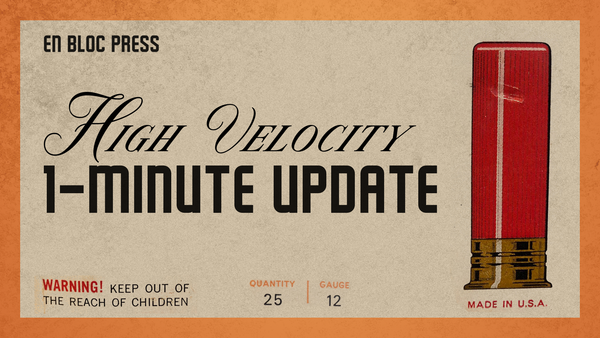Infopost: Ukraine and Strategic Mineral Resources
Research info on Ukraine's mineral resources...

I didn't really know much about the situation, so I used Perplexity's new "Deep Research" tool to generate a short report on what's going on. As with most AI, I expect it's 95% correct and 5% off in the more nuanced details, but I found it helpful, so I'll share.
It seems obvious that the Ukraine resource deal ties into American re-investment and chip manufacturing. I may have more to come on that, but I wanted to share this bit on Ukraine for now, as it's timely.


Ukraine's Strategic Mineral Resources and U.S. Negotiations for Access
As global demand for critical minerals surges amid technological and geopolitical competition, Ukraine has emerged as a focal point in U.S. efforts to diversify supply chains away from Chinese dominance. Ukraine holds vast reserves of rare earth elements, titanium, lithium, graphite, and other minerals essential for defense, renewable energy, and advanced manufacturing. Since 2022, the Trump administration has sought to secure mining rights to these resources as part of a broader strategy linking U.S. military aid to economic concessions. Negotiations have centered on proposals for the U.S. to acquire up to 50% ownership or revenue shares in Ukrainian mineral projects, but Kyiv has resisted these terms, demanding binding security guarantees and compliance with its legal framework. The outcome of these talks could reshape Ukraine’s post-war economy and the global balance of critical mineral production.
Ukraine’s Mineral Wealth and Global Significance
Rare Earth Elements and Strategic Metals
Ukraine’s mineral wealth includes approximately 20,000 deposits spanning 116 types of minerals, with rare earth elements (REEs) and critical metals forming a cornerstone of its resource base[1][2]. These include:
- Titanium: Ukraine possesses Europe’s largest titanium reserves, estimated to meet U.S. and EU demand for over 25 years[2:1]. Titanium is vital for aerospace and defense applications, with Ukrainian ilmenite (a titanium-iron oxide mineral) deposits like the Stremyhorodske field—comparable to Norway’s Tellnes and Canada’s Lac Tio—remaining underdeveloped due to the war[2:2][3].
- Lithium: Though smaller in global terms, Ukraine’s lithium reserves represent a third of Europe’s proven deposits, positioning it as a potential supplier for the EU’s battery industry[2:3]. Three of Ukraine’s four lithium sites are in Russian-occupied territories, complicating extraction[2:4][4].
- Graphite: Six known deposits, including those licensed to Australian firm Volt Resources, could supply anode materials for electric vehicle batteries. Modernizing these projects requires ~$650 million in investment[2:5].
- Beryllium and Rare Earths: The Perzhansk deposit contains 13.9 kilotons of beryllium oxide (critical for nuclear reactors), while rare earth metals like gallium and germanium are tied to phosphate and coal deposits[2:6].
Prior to Russia’s invasion, Ukraine produced 5% of the world’s gallium and was a key neon gas supplier for semiconductor manufacturing[1:1]. However, 85% of its mineral deposits remain unexplored, with active mining concentrated in conflict zones like Donbas[1:2][5].
U.S. Proposals and Ukrainian Resistance
The Trump Administration’s Demands
The U.S. has pursued a transactional approach, framing mineral access as compensation for over $500 billion in military and economic aid provided since 2022[6][7]. Key proposals include:
- 50% Ownership or Revenue Sharing: A draft agreement presented by Treasury Secretary Scott Bessent in February 2025 sought U.S. control over half of Ukraine’s rare earth mining rights and revenue, with disputes adjudicated in New York courts[8][7:1][5:1]. The deal excluded security guarantees, instead offering vague promises of a “long-term economic partnership”[8:1][3:1].
- Troop Deployment for Security: U.S. officials suggested deploying American forces to protect mining sites post-conflict, contingent on a peace deal with Russia[7:2][9].
- Legal Overrides: Initial drafts proposed superseding Ukrainian trade agreements and subsoil ownership laws, which designate mineral resources as national property[10][4:1].
Kyiv’s Counterarguments
President Volodymyr Zelenskyy rejected the terms as “colonial,” insisting any agreement must:
- Include binding NATO-style security guarantees against future Russian aggression[8:2][11][4:2].
- Involve European partners to avoid overreliance on the U.S.[8:3][9:1].
- Adhere to Ukrainian law, requiring parliamentary approval and equitable profit-sharing[12][4:3].
Ukrainian officials criticized the lack of transparency, noting the initial proposal arrived hours before Bessent’s visit and demanded immediate signing without consultation[12:1][3:2]. They also highlighted the risks of ceding control over resources in occupied territories, where Russia has already seized coking coal and titanium assets[6:1][1:3].
Geopolitical Implications
Reducing Reliance on China
China currently controls 90% of rare earth processing and 80% of lithium refining, leveraging this dominance in trade disputes[1:4][2:7]. U.S. access to Ukrainian minerals would weaken Beijing’s stranglehold on sectors like semiconductors and electric vehicles. For example:
- Ukrainian titanium could offset dependence on Russian VSMPO-Avisma, which supplies Boeing and Airbus[2:8].
- Graphite and lithium projects could diversify battery supply chains currently centered in China[2:9][4:4].
Russia’s Strategic Calculations
Moscow’s invasion partially aimed to capture mineral-rich regions like Donbas, which hold $14.8 trillion in resources according to Ukrainian estimates[6:2][1:5]. Securing these areas would bolster Russia’s own critical mineral exports while denying rivals access. The ongoing battle for Pokrovsk has already shut Ukraine’s last coking coal mine, illustrating the war’s resource-driven stakes[6:3][1:6].
European Union’s Role
In 2021, the EU signed a critical raw materials partnership with Ukraine, aiming to integrate its mining sector into European supply chains[1:7]. However, U.S. proposals risk sidelining European firms, with Zelenskyy advocating for multilateral involvement to balance influence[8:4][9:2].
Challenges to Development
Wartime Disruptions
- Occupied Deposits: Over 60% of Ukraine’s oil, gas, and critical mineral reserves are in Russian-held or frontline areas[1:8][2:10]. The Azov rare earth deposit and Novopoltava phosphate site—key REE sources—are under occupation[2:11].
- Infrastructure Damage: Bombing has destroyed mining facilities, including the Zaporizhzhia Titanium Plant, once a major supplier of titanium sponge[2:12].
Investment and Regulatory Hurdles
Developing Ukraine’s minerals requires $150–650 million per project for exploration and processing infrastructure[2:13]. While foreign companies like Australia’s Volt Resources and Turkey’s Onur Group have acquired licenses, political instability deterred major investments pre-war[2:14]. Post-war success hinges on:
- Legal reforms to attract private capital while retaining state oversight[2:15][4:5].
- Technology transfers for refining and metallurgy, areas where Ukraine lags[2:16].
Sovereignty Concerns
Critics liken U.S. demands to 19th-century resource extraction models, arguing that outsourcing mineral wealth undermines Ukraine’s economic sovereignty[10:1][4:6]. Constitutional mandates requiring parliamentary approval for resource deals further complicate negotiations[12:2][4:7].
The Path Forward
Revised Proposals and Diplomacy
Following backlash, the U.S. submitted an updated draft in late February 2025, removing contentious clauses like New York jurisdiction and revenue splits[12:3]. Zelenskyy signaled openness to a “24/7” negotiation process during meetings with U.S. envoy Keith Kellogg, emphasizing the need for mutual benefits[9:3][12:4].
Integrating Security and Economics
A viable agreement must link mineral access to:
- Security Guarantees: Formal NATO membership or bilateral defense pacts to deter Russia[8:5][11:1].
- Technology Partnerships: Joint ventures to build smelters and processing plants, adding value within Ukraine[2:17][4:8].
- Transparency: Public oversight to counter corruption risks in licensing[4:9].
Conclusion
Ukraine’s mineral resources represent both a strategic asset and a vulnerability. While U.S. access could accelerate post-war recovery and global supply chain diversification, unequal terms risk perpetuating dependency. Zelenskyy’s insistence on security-first deals reflects lessons from earlier Russian aggression, where resource control enabled geopolitical coercion. A balanced agreement—combining Western investment, Ukrainian ownership, and NATO security—offers the best path to stabilizing the region and reducing reliance on adversarial suppliers like China and Russia. However, achieving this will require compromises from all parties, recognizing that minerals alone cannot substitute for lasting political and military resolve.
https://theconversation.com/ukraines-natural-resources-are-at-centre-stage-in-the-ongoing-war-and-will-likely-remain-there-249254 ↩︎ ↩︎ ↩︎ ↩︎ ↩︎ ↩︎ ↩︎ ↩︎ ↩︎
https://www.mining.com/ukraine-and-us-partner-in-critical-minerals-sector/ ↩︎ ↩︎ ↩︎ ↩︎ ↩︎ ↩︎ ↩︎ ↩︎ ↩︎ ↩︎ ↩︎ ↩︎ ↩︎ ↩︎ ↩︎ ↩︎ ↩︎ ↩︎
https://www.nytimes.com/2025/02/15/world/europe/ukraine-minerals-us-deal-rejected.html ↩︎ ↩︎ ↩︎
https://www.pbs.org/newshour/world/the-u-s-presented-ukraine-with-proposal-to-access-its-minerals-offering-no-guarantees-in-return ↩︎ ↩︎ ↩︎ ↩︎ ↩︎ ↩︎ ↩︎ ↩︎ ↩︎ ↩︎
https://www.mining.com/web/ukraine-rejects-us-bid-for-50-of-rare-earth-minerals-ft-says/ ↩︎ ↩︎
https://www.npr.org/2025/02/14/g-s1-49120/ukraine-rare-earths-us-aid ↩︎ ↩︎ ↩︎ ↩︎
https://www.nbcnews.com/politics/national-security/trump-officials-us-owning-half-ukraine-rare-earth-minerals-rcna192325 ↩︎ ↩︎ ↩︎
https://www.mining-technology.com/news/ukraine-denies-us-proposal-mineral-rights-seeks-better-security-guarantees/ ↩︎ ↩︎ ↩︎ ↩︎ ↩︎ ↩︎
https://www.mining.com/web/us-ukraine-ramp-up-talks-on-minerals-deal-during-envoy-trip/ ↩︎ ↩︎ ↩︎ ↩︎
https://www.cnn.com/2025/02/21/politics/trump-ukraine-mineral-deal-analysis/index.html ↩︎ ↩︎
https://www.nbcnews.com/video/trump-s-proposal-for-security-in-exchange-for-mineral-rights-creates-dilemma-for-ukraine-232604229984 ↩︎ ↩︎
https://www.axios.com/2025/02/20/us-ukraine-rare-earth-minerals-agreement ↩︎ ↩︎ ↩︎ ↩︎ ↩︎





